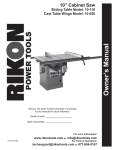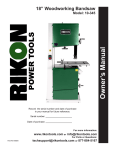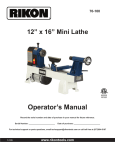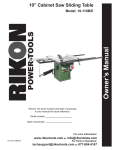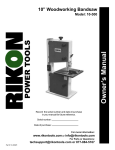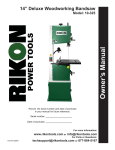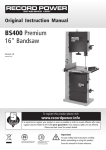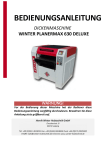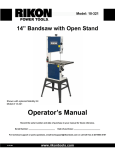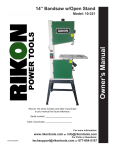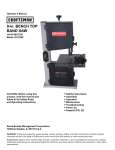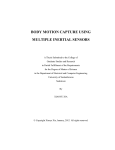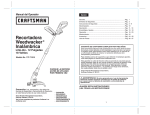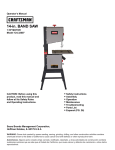Download Rikon Power Tools 10-110E Owner`s manual
Transcript
14” Professional Bandsaw Owner’s Manual Models: 10-350/10-350BAL Record the serial number and date of purchase in your manual for future reference. Serial number: Date of purchase: For more information: www.rikontools.com or [email protected] For Parts or Questions: Part #10-350M1 [email protected] or 877-884-5167 Operator Safety: Required Reading IMPORTANT! Safety is the single most important consideration in the operation of this equipment. The following instructions must be followed at all times. There are certain applications for which this tool was designed. We strongly recommend that this tool not be modified and/ or used for any other application other than that for which it was designed. If you have any questions about its application, do not use the tool until you have contacted us and we have advised you. General Safety Warnings KNOW YOUR POWER TOOL. Read the owner’s manual carefully. Learn the tool’s applications, work capabilities, and its specific potential hazards. ALWAYS GROUND ALL TOOLS. If your tool is equipped with a three-pronged plug, you must plug it into a three-hole electric receptacle. If you use an adapter to accommodate a two-pronged receptacle, you must attach the adapter plug to a known ground. Never remove the third prong of the plug. ALWAYS AVOID DANGEROUS ENVIRONMENTS. Never use power tools in damp or wet locations. Keep your work area well lighted and clear of clutter. ALWAYS REMOVE THE ADJUSTING KEYS AND WRENCHES FROM TOOLS AFTER USE. Form the habit of checking to see that keys and adjusting wrenches are removed from the tool before turning it on. ALWAYS KEEP YOUR WORK AREA CLEAN. Cluttered areas and benches invite accidents. ALWAYS KEEP VISITORS AWAY FROM RUNNING MACHINES. All visitors should be kept a safe distance from the work area. ALWAYS MAKE THE WORKSHOP CHILDPROOF. Childproof with padlocks, master switches, or by removing starter keys. NEVER OPERATE A TOOL WHILE UNDER THE INFLUENCE OF DRUGS, MEDICATION, OR ALCOHOL. ALWAYS WEAR PROPER APPAREL. Never wear loose clothing or jewelry that might get caught in moving parts. Rubber-soled footwear is recommended for the best footing. ALWAYS USE SAFETY GLASSES AND WEAR HEARING PROTECTION. Also use a face or dust mask if the cutting operation is dusty. NEVER OVERREACH. Keep your proper footing and balance at all times. NEVER STAND ON TOOLS. Serious injury could occur if the tool is tipped or if the cutting tool is accidentally 2 ALWAYS DISCONNECT TOOLS. Disconnect tools before servicing and when changing accessories such as blades, bits, and cutters. ALWAYS AVOID ACCIDENTAL STARTING. Make sure switch is in “OFF” position before plugging in cord. NEVER LEAVE TOOLS RUNNING UNATTENDED. ALWAYS CHECK FOR DAMAGED PARTS. Before initial or continual use of the tool, a guard or other part that is damaged should be checked to assure that it will operate properly and perform its intended function. Check for alignment of moving parts, binding of moving parts, breakage of parts, mounting, and any other conditions that may affect its operation. A guard or other damaged parts should immediately be properly repaired or replaced. Special Safety Rules For Bandsaws 1. Always allow the Bandaw blade to stop before removing scrap pieces from table. 2. Always keep hands and fingers away from the blade. 3. Never attempt to saw stock that does not have a flat surface, unless a suitable support is used. 4. Always hold material firmly and feed it into the blade at a moderate speed. 5. Always turn off the machine if the material is to be backed out of an uncompleted cut. 6. Adjust the upper guide about 1/8” above the material being cut. 7. Check for proper blade size and type for thickness and type of material being cut. 8. Make sure that the blade tension and blade tracking are properly adjusted. 9. Make “relief” cuts before cutting long curves. 10. Release blade tension when the saw will not be used for a long period of time. California Proposition 65 Warning WARNING: Some dust created by power sanding, sawing, grinding, drilling, and other construction activities contains chemicals known to the State of California to cause cancer and birth defects or other reproductive harm.Your risk from exposure to these chemicals varies, depending on how often you do this type of work. To reduce your exposure, work in a well-ventilated area and with approved safety equipment, such as dust masks that are specially designed to filter out microscopic particles. For more detailed information about California Proposition 65 log onto rikontools.com. Note: This owner’s manual is not a teaching aid. Use of this owner’s manual is intended to show assembly, adjustments, and general use. SAVE THESE INSTRUCTIONS. Refer to them often. 3 Table of Contents Safety Warnings..................................................................................................................................................2 -3 Bandsaw Safety Rules ..........................................................................................................................3 Specifications ........................................................................................................................................4 Contents of Package ............................................................................................................................5 Loose Parts ...........................................................................................................................................6 Getting To Know Your Bandsaw ............................................................................................................7 Table Assembly .....................................................................................................................................8 Rip Fence Assembly .............................................................................................................................8 Hand-Wheel Assembly .........................................................................................................................8 Setting 90o Table Stop ...........................................................................................................................9 Tilting the Table .....................................................................................................................................9 Tracking Blade ......................................................................................................................................10 Adjusting Blade Tension .......................................................................................................................10 Blade Tension Indicator Adjustment.......................................................................................................10 Changing the Bandsaw Blade........................................................................................................11 Upper Blade Guide Adjustment ..........................................................................................................12 Lower Blade Guide Adjustment ..........................................................................................................12 Adjusting the Cutting Height ..................................................................................................................12 Changing Blade Speed .......................................................................................................................13 Setting Drive Belt Tension.......................................................................................................................13 Operation ............................................................................................................................................13-15 Electrical Requirements ..................................................................................................................................16 Maintenance................................................................................................................................... ..... 17 Wiring Diagram ...................................................................................................................................17 Troubleshooting .........................................................................................................................18-19 Changing Bandsaw Tire ..................................................................................................................................19 Adjusting Fence 90 Degrees to the Table..................................................................................................................19 Parts Diagrams/Lists ................................................................................................................................20-29 How To Guide .....................................................................................................................................30 Warranty .............................................................................................................................................31 Specifications 10-350 Throat Width Max. Cutting Depth Blade Length Blade Width Table Size Table Tilt Blade Speeds Motor Amps/Speed Volts Net weight 10-350BAL 13-9/16” Throat (345width mm) 13-9/16” (345 mm) 13-15/16” Max.(356 cutting mm) depth 13-15/16” (356 mm) 124” (3150 Blade mm) length 124” (3150 mm) 1/4” –Blade 1”(6-25 width mm) 1/4” – 1”(6-25 mm) 21-1/16” Table x 19-1/16” size (535 mm x 485 mm) 21-1/16” x 19-1/16” (535 mm x 485 mm) o o Left-10 Table Right-45 tilt Left-10o Right-45 o 2132 Blade ft/min or speeds 4101 ft/min 2163 ft/min or 4162 ft/min 2.5 HP Motor (RIKON) 3 HP (Baldor) 10A / Amps 1700 RPM 12.5A / 1725 RPM 220V Volts 230V 308 lbs Net weight 315 lbs 4 Contents of Package Model 10-350 14” Professional Bandsaw is shipped complete in one crate. Model 10-350BAL is shipped in two cartons unless otherwise noted. Unpacking and Checking Contents a. Separate all “loose parts” from packaging materials and check each item with “Table of Loose Parts” to make sure all items are accounted for, before discarding any packaging material. b. Thread hoist ring into threading hole on top of Bandsaw frame. This allows the user to connect a properly secured hoist mechanism to lift the Bandsaw. c. With the help of another person or by installing hoist ring, unbolt the Bandsaw from the packing pallet. Properly lift the Bandsaw off the packing pallet and place on level floor. d. Remove protective oil that is applied to the table. Use any ordinary house hold type grease or spot remover. e. Apply a coat of paste wax to the table to prevent rust. Wipe all parts thoroughly with a clean TABLE OF LOOSE PARTS Item Part Name Qty A Bandsaw Assembly 1 B Table w/insert 1 C Owner’s manual 1 D Parts Package 1 1 E Parts Package 2 1 D B 14” Professional Bandsaw Models: 10-350/10-350BAL Owner’s Manual A C Record the serial number and date of purchase in your manual for future reference. Serial number: Date of purchase: For more information: www.rikontools.com or [email protected] For Parts or Questions: Part #10-350M1 [email protected] or 877-884-5167 5 E Loose Parts List LIST OF LOOSE PARTS Table assembly: A. Table B. Table leveling bar and hardware C. 90° table stop bolt D. Table mounting bolts and washers D C A B A Rip fence assembly: A. Fence bar B. Fence C. Fence carrier D. Resaw bar D B C A Tool holder assembly: A. L wrench 2.5MM B. L wrench 3MM C. L wrench 4MM D. L wrench 5MM E. L wrench 6MM F. 10mm wrench G.13mm wrench B C D E F G 6 Getting to Know Your Bandsaw A F G P B H Q C I J D R K S E T L M U N V O A. Hoist Ring B. Tension Indicator Window C. Blade Tension Hand-Wheel D. Switch E. Rip Fence F. Guide Post Cap G. Blade Tracking Window H. Guide Post Rise/Fall Handle I. Guide Post Lock Knob J. Hinged Blade Guard K. Blade Guides L. Work Table M. Drive Belt Tension Wheel N. 4” Dust Ports O. Foot Break P. Blade Tracking Knob Q. Quick Release Lever R. Tool Holder S. LED Light T. Table Tilt & Lock Knobs U. Power Control Box V. Motor 7 Assembly Blade Slot Work Table Assembly Installing Table Leveling Bar: Locate the table leveling bar, two hex socket screws and two washers (A-Fig.1 Inset). Insert a hex socket screw and washer through the left hole of the table leveling bar and into the threaded hole on the left side of the blade slot (B-Fig.1). Make sure that the opening of the slot on the right side of the table leveling bar faces toward the table trunnion. This will allow the table leveling bar to open outward from the bandsaw. Table Leveling Bar B Underside of Table A Figure 1 Rip Fence Assembly With a 13mm wrench, remove one 13mm hex nut and one washer from each stud on the fence bar (A-Fig.2). Leave one each of 13mm hex nut and washer on each stud on the fence bar. The remaining nut and washer will be used for drift adjustments that will be described later in this manual. A Figure 2 Next, install the fence bar studs into the table as shown (Fig.3). Locate the 13mm hex nuts and washers removed in Fig.10 and install on the opposite ends of each fence bar stud. NOTE: It may be necessary to open the table leveling bar to gain access to the right side fence bar stud. Hand Wheel Installation A There are two hand wheels used on the 10-350 bandsaw. The first controls the height of the upper guide post, the second adds/removes tension on the drive belt. Figure 3 Attach the first hand wheel (Fig.4) to the rack and pinion shaft on the upper part of the bandsaw, using the 5mm “L” wrench provided. Attach the second crank handle to the belt and speed control rod located below the 4” dust port, using the 5mm “L” wrench provided. 8 Figure 4 Assembly Adjustments Storage for the “L” wrenches is provided for quick access when adjustments are needed. Tool Holder Place the (4) “L” wrenches (3mm, 4mm, 5mm and 6mm) in the tool holder on the rear column support (Fig.5). Setting the Table Square to Saw Blade The table may be set at 90° to the saw blade sides by adjusting the table stop screw under the table. The table stop screw rests on the top of the quick release adjustment stop. By first loosening the locking nut (A-Fig.6) and then adjusting the screw (B-Fig.6), the table can be set correctly. Retighten the locking nut (A-Fig.6) making sure that the setting is maintained. The table may also be set at 90° to the back of the saw blade by adjusting the four trunnion micro adjustment screws (A-Fig.7). First, slightly loosen part #98 (refer to parts explosion on page 18 of this manual). Using the 3mm “L” wrench, turn the rear trunnion micro adjusting screws part #125. Turning the screws clockwise will raise the trunnion; counterclockwise will lower. Check table for 90° and tighten part #98. (Trunnion has been removed from bandsaw for clarity. Micro adjusting screws are raised to exaggerate location. Only two of the four micro adjusting screws shown.) Figure 5 A B Figure 6 A Figure 7 Tilting the Table Loosen the lock handle (A-Fig.8) on the table trunnion. Turn the table tilting knob (B-Fig.8) to adjust the table to the desired angle. Use the angle indicator scale on the trunnion bracket to find the desired angle. Retighten the lock handle to secure the table. B A Figure 8 9 Adjustments Tracking the Saw Blade Warning! Unplug the bandsaw. Make sure the upper and lower blade guides are adjusted away from the blade and the tension scale is set to correspond to the width of the blade you are using. B A Note: The blade tension scale may read differently due to cut specifications of the blade manufacturer. It might be necessary to increase/decrease tension up/down one size on blade tension scale to achieve proper blade tension. Figure 9 Open both doors. Loosen the lock lever (A-Fig.9) by turning it counter clockwise and turn the blade tracking knob (B-Fig.9) clockwise/counterclockwise while turning the upper wheel by hand at least three rotations until the blade tracks centered on the wheel. Finally, tighten the lock lever and close the doors. Quick Release Adjusting the Blade Tension The 10-350 has a quick release blade function which allows for fast blade changing and tensioning. The quick release lever is shown in figure 10. To loosen the tension of the blade, turn the blade tension handwheel (A-Fig.11) counter clockwise. To tighten the tension of the blade, turn the blade tension handwheel clockwise. Off On Figure 10 B Tension the blade until the tension readings correspond to the width of blade you are using by viewing through the tension indicator window (B-Fig.11). A Note: The blade tension scale may read differently due to cut specifications of the blade manufacturer. It might be necessary to increase/decrease tension up/down one size on blade tension scale to achieve proper blade tension. Figure 11 Caution! Always tension the blade with the quick release lever in the “On” position. Failure to do so could result in lack of blade tension or tension failure. A Blade Tension Indicator Adjustment The blade tension indicator can be adjusted for blades known to be cut over/under length by different manufacturers. With moderate tension on the blade loosen the two adjusting screws with a Phillips-head screw driver (A-Fig.12). Adjust the blade indicator bracket up/down as needed (B-Fig.12) and re-tighten the two adjusting screws. 10 B Figure 12 Adjustments Changing the Bandsaw Blade A Warning! Unplug the machine from the electrical supply. This ensures that the Bandsaw will not accidentally turn on if the ON/OFF switch is bumped. a) Open the top and bottom wheel doors by turning the door locking knobs. (A-Fig.13) b) Release the blade tension by moving the quick release lever (Fig.14) from right to left. Open the hinged door on the blade guard by loosening the wing screw (A-Fig.15). Loosen then open the table leveling bar (A-Fig.16). c) Remove the saw blade by feeding it through the slot in the table (B-Fig.16), upper and lower blade guides and the slot in the spine of the machine, being careful not to cut yourself. Wear gloves for protection. d) When installing the new blade, ensure the blade teeth are pointing downwards and towards you at the position where the blade passes through the table. e) Center the blade on both wheels. f ) Re-tension the new blade by moving the quick release lever (Fig.14) left to right and check the blade tracking. Spin the upper wheel clockwise three times. The blade should run in the center of both wheels. Refer to “Tracking the Saw Blade” on page 10 for more details. g) Set the blade guides as described in the section “Adjusting the Blade Guides” on page 12. h) Close the hinged door on the blade guard and tighten the wing screw (A-Fig.15). Close the table leveling bar and tighten (A-Fig. 16). i) Close and lock both the wheel doors (A-Fig.14) before reconnecting the power supply. Figure 13 A Quick Release On Off Off On Figure 14 A Hinged Door Figure 15 B A Figure 16 11 Adjusting the Blade Guides A Upper Guides: To adjust the upper blade guides, first position the roller guides relative to the blade by loosening the Allen cap head screw (A-Fig.17) and sliding the guide assembly until the side roller guides are approximately 1/16” behind the gullet of the blade then tighten the Allen cap head screw (A-Fig.17). Next set the roller guides to within 1/32” of the blade by releasing the lock knob (B-Fig.17) and turning the micro-adjusting knob (C-Fig.17). Do not set the guides too close, as this will adversely affect the life of the blade. When the correct adjustment is reached, lock the guides in position by tightening the lock knob (B-Fig.17). Finally, follow the same steps above to position the rear thrust roller guide. Lower Guides: To adjust the lower blade guides, first loosen the hex nut (A-Fig.18) then move the lower guide support casting to allow the side roller guides to be approximately 1/16” behind the gullets of the blade and tighten the hex nut (A-Fig.18). Next set the roller guides to within 1/32” of the blade by releasing the lock knob (B-Fig.18) and turning the micro-adjusting knob (C-Fig.18). Do not set the guides too close, as this will adversely affect the life of the blade. When the correct adjustment is reached, lock the guides in position by tightening the lock knob (B-Fig.18). Adjust the thrust bearing to be just clear of the back of the blade by unlocking the hex nut (D-Fig.18), and turning adjusting knob on rear of the trunnion. Finally, tighten hex nut (D-Fig.18). Make sure doors are closed, turn the bandsaw on and inspect that the upper, lower and thrust bearings are not turning. All bearings should not turn unless pressure from workpiece is applied to the blade. If bearings are turning under no pressure, repeat steps to adjust the blade guides. B C Figure 17 D B A C Figure 18 B A Figure 19 Adjusting the Cutting Height Loosen the guidepost lock knob (A-Fig.19) and turn the guidepost handwheel (B-Fig.19) to raise or lower the guide post/upper blade guide assembly to the desired height. Then tighten the guidepost lock knob. Note: The bottom edge of the guide bearings should be approximately 1/4”above the top surface of the work piece. (Fig.20) 12 Approximately 1/4” Figure 20 Changing Blade Speed Pulley Setting Warning! Before changing the speed, always make sure the machine has been unplugged from the electrical supply. A The 10-350 has two pulley speed ranges, low speed (2132 ft/min) and high speed (4101 ft/min). The 10-350BAL has two pulley speed ranges, low speed (2163 ft/min) and high speed (4162 ft/min). The lower wheel (A-Fig.21) and the motor shaft have twin multi-vee pulleys (B-Fig.21). A flat ribbed “J” belt (C-Fig.21) passes around the wheel pulley, motor pulley and belt tension pulley. The belt tension is released and applied by using the handwheel (D-Fig.21). C B Tension Pulley For the high speed the belt should be fitted to the rear pulley on both the motor and the wheel (A-Fig.22). D Figure 21 For the low speed the belt should be fitted to the front pulley on both the motor and wheel (B-Fig.22). Setting Drive Belt Tension A To properly adjust belt tension, turn hand-wheel (D-Fig.21) until there is 1/2” deflection in the flat ribbed “J” belt. B Operation Switch Control Station Figure 22 The 10-350 has a key-on safety feature that will lock out unauthorized users such as students, coworkers or employees not trained or qualified to use the bandsaw. To operate the saw turn the key (A-Fig.23) to the right to activate the control station. A green light will illuminate (B-Fig.23) showing that the saw is ready for use. Press the green “START” button (C-Fig.23) to turn the saw on. Once the cut is finished press the “STOP” button to turn the saw off. A B C D Note: If working with large pieces and not able to reach the “STOP” button simply press the foot brake. There is a switch built into the foot break assembly that will turn the saw off. Figure 23 13 Adjusting the Rip Fence/Drift Align the fence assembly in or out until parallel with the side of the blade by turning the adjustment collars and the fence bolts accordingly (A-Fig.24). If the mounting bolts have been tightened, these will need loosened off before this adjustment can be made. The same adjustment can be made to compensate for blade drift. A Check that the fence is 90 degrees to the table using a suitable square. If no adjustments are needed fully tighten the fence bar nuts. If adjustment is required, raise or lower either side of the fence rail until the fence body is 90 degree to the table. Once set at 90 degrees, fully tighten the fence bar nuts. Re-sawing A resaw guide is supplied with this bandsaw to help correct any blade wandering during certain resawing operations. Figure 24 For resawing, attach the resaw bar to the slot on the fence. Position the resaw bar so that it is aligned with the front of the blade. Draw a reference line down the workpiece. Use the bar as a pivot point and follow the line through the cut. (Fig.25) Note: The resaw bar is not needed for all resaw operations. Proper blade tension and selection as well as proper guide set up will allow resawing flat stock against the fence. Pivot Workpiece Basic Operation Figure 25 The blade cuts on a continuous down-stroke. With both hands, firmly hold the workpiece down on the table, and feed it towards the blade slowly, keeping your hands away from the blade. For best results the blade must be sharp. A dull blade will not cut correctly, especially when straight cutting, and causes excess pressure to be applied on the rear guide bearings. Select the right blade for the job, depending on the thickness of the wood and the cut to be made. The thinner and harder the wood, the finer the teeth of the blade should be. Use a fine tooth blade for cutting sharp curves. The machine is especially suited for cutting curves, but will also make straight cuts. When cutting, follow the design marked out by pushing and turning the workpiece evenly. Do not attempt to turn workpiece without pushing it as this may cause the workpiece to get stuck, or the blade to bend. 14 Features and Safety The 10-350 14” Professional Bandsaw has many builtin safety and feature items shown below. LED Work Light The LED work light is built onto a long flexible goose neck giving it the ability to illuminate the work surface on both sides of the blade. To operate the LED work light depress the round button (A-Fig.26). LED lights are very bright and can wash out reference lines on a workpiece. If the light is too bright, move the goose neck away reducing the amount of light cast on the workpiece. Foot Brake The foot brake, when depressed will slow the blade to a stop. The foot brake (A-Fig.27) on the 10-350 will also shut off the bandsaw simultaneously. This is an added safety feature that allows you to handle large workpieces without having to reach back to the switch control station to the main “STOP” button. The lever, when depressed pivots the break pad (B-Fig.27) against the break disc (C-Fig.27) on the motor pulley. Quick Release Blade Tension Lever The tension lever that operates the quick release blade function has two of the most innovative features on the 10-350. One feature allows the blade tension to be released from back or front of the saw. The other feature disables the saw from operating if the quick release lever is not engaged with no tension on the blade. This prevents accidental starting while the tension lever is off and will eliminate the possibility of damaging a blade or the saw. Fig.28 Dual Door Safety Switches Both the upper and lower blade wheel doors are equipped with safety switches that will shut the saw off when opened. The saw will not operate until the blade wheel doors are closed. If a door is opened while the saw is running power to the motor will be cut off. The only way to restart the saw is to make sure both band wheel doors are closed before pressing the “START” button. 15 A Figure 26 C B A Figure 27 Operate Quick Release from the Front or Back of the Saw Figure 28 Electrical Requirements In the event of a malfunction or breakdown, grounding provides a path of least resistance for electric current to reduce the risk of electric shock. This tool is equipped with an electric cord having an equipment-grounding conductor and a grounding plug. The plug must be plugged into a matching outlet that is properly installed and grounded in accordance with all local codes and ordinances. Do not modify the plug provided. If it will not fit the outlet, have the proper outlet installed by a qualified electrician. Improper connection of the equipment-grounding conductor can result in a risk of electric shock. The conductor, with insulation having an outer surface that is green with or without yellow stripes, is the equipment-grounding conductor. If repair or replacement of the electric cord or plug is necessary, do not connect the equipment-grounding conductor to a live terminal. Check with a qualified electrician or service personnel if the grounding instructions are not completely understood, or if in doubt as to whether the tool is properly grounded. Use only three wire extension cords that have three-prong grounding plugs and three-pole receptacles that accept the tool’s plug.* Repair or replace a damaged or worn cord immediately. This tool is intended for use on a circuit that has an outlet that looks the one illustrated in Figure A below. The tool has a grounding plug that looks like the grounding plug as illustrated in Figure A below. * Canadian electrical codes require extension cords to be certified SJT type or better. ** Use of an adapter in Canada is not acceptable. Figure A 16 Maintenance Caution! BEFORE CLEANING OR CARRYING OUT MAINTENANCE WORK, DISCONNECT THE MACHINE FROM THE POWER SOURCE (WALL SOCKET). NEVER USE WATER OR OTHER LIQUIDS TO CLEAN THE MACHINE. USE A BENCH BRUSH. DO NOT USE COMPRESSED AIR NEAR BEARINGS. REGULAR MAINTENANCE OF THE MACHINE WILL PREVENT UNNECESSARY PROBLEMS. Keep the table clean to ensure accurate cutting. Keep the outside of the machine clean to ensure accurate operation of all moving parts and prevent excessive wear. Keep the ventilation slots of the motor clean to prevent it from overheating. Keep the inside (near the saw blade, etc.) clean to prevent accumulation of dust. Wiring Diagram WARNING! This machine must be grounded. Replacement of the power supply cable should only be done by a qualified electrician. 17 Troubleshooting WARNING! FOR YOUR OWN SAFETY, ALWAYS TURN OFF AND UNPLUG THE MACHINE BEFORE CARRYING OUT ANY TROUBLESHOOTING. TROUBLE PROBABLE CAUSE REMEDY The machine does not 1. No power supply. work when switched on. 2. Defective switch. Check the cable for breakage. Contact your local dealer for repair. The blade does not move with the motor running. 1. The quick release lever or blade tension handwheel has not been tightened. 2. The blade has come off one of the wheels. 3. The saw blade has broken. 4. The drive belt has snapped. Switch off the motor, tighten the quick release lever or blade tension handwheel. 1. Fence for cutting not used. 2. Too fast feed rate. Use a fence. Put light pressure on the workpiece & make sure the blade does not bend. Use a new blade. The blade does not cut in a straight line. The blade does not cut, or cuts very slowly. 3. The blade teeth are dull or damaged. 4. Blade guides not suitably adjusted. 1. The teeth are dull, caused by cutting hard material or long use. 2. The blade was mounted in the wrong direction. Sawdust builds up inside the machine. Sawdust inside the motor housing. The machine does not cut at 45o or 90o angles. The blade cannot be properly positioned on the bandwheels. Open the hinged door and check. Replace the blade. Replace the belt. Adjust the blade guides (see the section on page 12). Replace the blade, use a 6 T.P.I. blade for wood and soft materials. Use a 14 T.P.I. blade for harder materials. A 14 T.P.I. blade always cuts slower due to the finer teeth and the slower cutting performance. Fit the blade correctly. 1. This is normal Clean the machine regularly. Open the hinged door and remove the sawdust with a vacuum cleaner. 1. Excessive dust build-up on the machine exterior components. Clean the ventilating slots of the motor with a vacuum cleaner. From time to time remove the sawdust to prevent it from being sucked into the housing 1. The table is not at right angles to the blade. 2. The blade is dull or too much pressure was put on the workpiece. Adjust the table. 1. The wheels are not in alignment. Defective bearing. 2. The blade tracking knob hasn’t been properly adjusted. 3. Inferior blade. Contact Technical Support @ 877-884-5167 or [email protected]. Adjust the knob (see the section on page 10). Replace the blade or put less pressure on the workpiece. Replace the blade. For parts or technical questions contact: [email protected] or 877-884-5167. 18 Troubleshooting Adjusting the Upper Blade Guide Bearings Parallel to the Blade (Refer to “Guide Post Assembly” parts diagram on page 28) This step may not be necessary, it is factory preset. If adjustment is needed follow the steps below. First slightly loosen part #226 Hex Bolt M8X20 (4 each) on rear of upper bandsaw housing. This will allow you to adjust the micro adjustment screws #227 in part #224 Gear Bracket. Next place a 3mm “L” wrench through the sight holes in part #198 Cover. Turning clockwise on the micro adjustment screws in left two holes will adjust the left bearings to the right. Turning clockwise on the micro adjustment screws in the right two holes will adjust the right bearings to the left. Check bearings for parallel. Lastly tighten parts #226 Hex Bolt (4) on back of bandsaw housing. Repeat steps if the bearings are still not parallel. Adjust Upper Side Bearings Which Will Not Track Close to the Blade (Refer to “Guide Post Assembly” parts diagram on page 28) If the right or left upper guide bearings do not adjust to within 1/32” of the blade, the Guide Post (part #195) may need adjustment. First lower the Guide Post (part #195) all the way to the table. Second slightly loosen parts #226 Hex Bolt M8X20 (4) on the back of the upper bandsaw cabinet housing. Next swing the Guide Post (part #195) right or left until side guide bearings are properly spaced on each side of blade making sure that the blade will strike the center of the rear thrust bearing. Tighten part #226 Hex Bolt M8X20 (4) on the back of the upper bandsaw cabinet housing. Raise the Guide Post (part #195) seven inches off the table and check alignment. If side guide bearings travel out of alignment repeat steps above. Raise the Guide Post (part #195) to the top of the travel and check final alignment. Repeat steps above if necessary. Changing Bandsaw Tire Use a putty knife to get underneath the tire and pull it up and away from the wheel. Work the putty knife all the way around the wheel to loosen the tire. Then, use the putty knife as leverage to flip the tire over and off of the wheel. Clean the inside of the groove, removing any dirt, debris or cement with lacquer thinner. Soak the replacement tire in warm water to make it more flexible. Let tire dry and lay on top of wheel. Start by setting the tire into the wheel groove at the top of the wheel. Using a putty knife, work the new tire around the wheel, making sure not to slice the tire. If rubber cement is to be used, make sure to distribute evenly. Having high spots between the wheel and the tire will cause a vibration and effect blade tracking. 19 Parts Diagram Frame Assembly 20 Parts List Frame Assembly Key No. 1 2 3 4 5 6 7 8 9 10 11 12 13 14 15 16 17 18 19 20 21 22 23 24 25 26 27 28 29 30 31 32 33 34 35 36 37 38 39 40 41 42 43 44 45 46 47 48 Part No. M8X16GB825Z ST3D5X19GB845Z WSH4GB96Z JL20073003 KW3-0Z-2B JL20073002 JMBS1402011000 RVT4X8GB12618 JL22010008 RVT3X7GB12618A JL26010001 JMBS1402012000 M6GB889Z JL26010007 M6X25GB70Z hy57b LA39 LA42Y2-10/B M4X10GB818Z JMBS1402010003 PL3 JL27010005 M5X10GB818Z JMBS1402010001 WSH5GB97D1Z JL26010010 JMBS1402013000 M4X30GB818Z QKS7-01 M6X16GB70Z WSH6GB97D1Z JMBS1402010002 M8GB6170Z M6X30GB70Z M6GB6170Z FDPT1202020021 M8X16GB70Z M6X20GB70Z WSH6GB93Z WSH6GB97D1Z JXBS2401015101 JMBS1402015001 JMBS1402015100 M10GB889Z WSH10GB97D1Z JL26010006 JXBS2401015005 JL26010013 Description Ring Tap screw Washer Micro-switch cap Switch Micro-switch cover Frame Rivet Leaf spring Rivet Clear window Upper door assm. Locking nut Tube Hex socket screw M6X25 Stop switch box Button Key switch Pan head screw Switch plate Stop switch Pointer plate Pan head screw Pointer Flat washer Pointer screw Lower door assm. Pan head screw Microswitch Hex socket screw M6X16 Flat washer Micro-switch plate Nut Hex socket screw M6X30 Nut Spring Hex socket screw M8X16 Hex socket screw M6X20 Spring washer Flat washer Pedal Lever Brake block Locking nut Flat washer Knob Side cover Plate Key No. 49 50 51 52 53 54 55 56 57 58 59 60 61 62 63 64 65 66 67 68 69A 69B 70 71 72 73 74 75 76 77 78 79 80 81 82 83 84 85 86 87 88 89 90 91 92 93 94 21 Part No. WSH6GB96Z M6X16GB5783Z M6GB889Z M6X25GB5783Z JL26010003 WSH6GB96Z M6GB6170Z M8GB889Z JL26010014 JL26010015 JMBS1402020002 JMBS1402020003 M8X10GB80B JL26020012 JL20010015 M5X8GB78Z JMBS1402023003 M8X20GB5783Z WSH8GB97D1Z WSH8GB862D2Z H8022684-01 35LYY983 M8X25GB5783Z M8GB6170Z JMBS1402020004 CLP17GB894D1B BRG80101GB278 JMBS1402023002 JMBS1402023001 CLP28GB893D1B CLP12GB894D1B WSH27GB93B M27X2GB6171Z JL48091100 1905010A QSK-02 M4X30GB819Z JMBS1402070000 M4X15GB819B JL60010004 JMBS1402010005 JL26030016 JL26030015 JMBS1402010004 M5X10GB70Z M4GB6170Z JL26020014 Description Washer Bolt M6X16 Locking nut Hex bolt M6X25 Brush Washer Hex nut M6 Locking nut M8 Seat pad Screw shaft Drive belt Motor pulley Hex screw M8X10 Small handwheel Retaing ring Screw M5X8 Thread rod Hex screw M8X20 Flat washer Washer 2.5HP RIKON Motor 3HP Baldor Motor Hex screw M8X25 Hex nut M8 Lower bearing bolt Retaining ring Bearing Sliding shaft Tension wheel Retaing ring Retaing ring Spring washer Nut M27X2 Relay Bushing Microswitch Screw M4X30 Light Screw M4X15 Bushing Upper guide cover Thread handle Adjusting Knob Indicator light Hex socket screw M5X10 Nut M4 Small handwheel Parts Diagram Wheel Assembly 22 Parts List Wheel Assembly Key No. 95 96 97 98 99 100 101 102 103 Part No. WSH8GB96Z M8X16GB70Z JMBS1402020001 JMBS1402022100 JL28020004 JL21022002A CLP40GB893D1B BRG180203GB278 JL28022001 Description Washer Hex socket screw M8X16 Blade Lower wheel assm. Bushing Tire Retaining ring Bearing Upper wheel 23 Parts Diagram Table & Fence Assembly 24 Parts List Table & Fence Assembly Key No. 104 105 106 107 108 109 110 111 112 113 114 115 116 117 118 119 120 121 122 123 124 125 126 127 128 129 130 131 132 Part No. JMBS1602060001 JMBS1601060002 WSH6GB97D1Z WSH6GB93Z M6X16GB70Z JL20024001 JL20024002 JMBS1601060003 JL28060010 JMBS1602060002 JL28060005A WSH8GB97D1Z WSH8GB93Z M8GB6170Z JL27050009 WSH8GB96Z JL20030003 M8X25GB70Z JL26041006 BRG6201GB276 WSH8GB97D1Z JL26052001 M6GB6172Z M6GB41Z JL26052002 M12X90GB801Z M5X10GB70Z M5X50GB70Z M10GB889Z Description Key No. Rip fence Locking Plate Washer Spring washer Hex socket screw M6X16 Adjusting Knob cap Adjusting Knob body Knob seat Clip Fence rail Support shaft Washer Spring washer Hex nut M8 Support plate Washer Wing knob Hex socket screw M8X25 Bearing bushing Bearing Washer Support rod Nut M6 Nut M6 Adjusting handle Carriage bolt M12x90 Hex socket screw M5X10 Hex socket screw M5X50 Locking nut 133 134 135 136 137 138 139 140 141 142 143 144 145 146 147 148 149 150 151 152 153 154 155 156 157 158 159 160 161 25 Part No. WSH10GB97D1Z M12X30GB5781B WSH12GB97D1B WSH12GB93B JL26050002B JL26055000 FDPT1202040015 M6X10GB70Z WSH6GB96Z JL26050011 JL26050005A ST2D9X6D5GB845Z JMBS1402016001 JMBS1402051009 CLP6GB896B JMBS1402051004 JMBS1402051005 JMBS1402051003 CLP12GB894D1B BRG6001-2RSGB276 JMBS1402051006 M6X30GB70Z JL26050004C M8X20GB5783Z WSH8GB97D1Z M8GB6170Z M8X50GB5783Z JMBS1602030001 JL26050008 Description Washer Screw M12X30 Washer Spring washer Lower table trunnion Gear Locking handle Hex socket screw M6X10 Washer Guide shaft Pointer Pan head screw Lower guide body Washer Ring Tube Threaded shaft Lock plate Retaining ring Bearing Bushing Hex socket screw M6X30 Upper table trunnion Hex screw Washer Nut M8 Bolt M8X50 Table Table insert Parts Diagram Blade Tension/Tracking 26 Parts List Blade Tension/Tracking Key No. 164 165 166 167 168 169 170 171 172 173 174 175 176 177 178 179 180 181 182 183 184 185 186 187 188 189 190 191 192 193 194 Part No. Description M10GB6170Z WSH10GB93B M12GB923Z WSH12GB93B M10GB889Z WSH10GB97D1Z JXBS1801030006 JXBS1801030007 JXBS1401030002 JMBS1402040011 JMBS1402040010 JMBS1402040001 M5X10GB70Z PIN3X30GB879D1B JMBS1402040012 JMBS1402040009 BRG51102GB301 JMBS1402040005 JMBS1402040006 BRG51105GB301 JMBS1402040007 M10X30GB70Z JMBS1402040008 JMBS1402040003 JMBS1402040004 JXBS2201023004 WSH20GB95Z WSH40GB1972A WSH12GB96Z M6X12GB80B M10GB6170Z Hex nut M10 Spring washer Nut M12 Spring washer Locking nut Flat washer Bolt Threaded rod Slide rod Upper wheel shaft Bushing Switch plate Hex socket screw M5X10 Roll pin Threaded plate Threaded rod Bearing Upper block Lower block Bearing Support plate Hex socket screw M10X30 Knob bushing Knob lever Knob Small handwheel Flat washer Spring Washer Hex screw M6X12 Nut M10 27 Parts Diagram Guide Post Assembly 28 Parts List Guide Post Assembly Key No. 195 196 197 198 199 200 201 202 203 204 205 206 207 208 209 210 211 212 213 214 215 216 217 218 219 220 221 222 223 224 225 226 227 228 229 230 231 232 233 234 235 236 237 238 239 240 241 Part No. Description JMBS1402050001 JMBS1402050002 M4X10GB819Z JL26040002 M8X10GB70Z JMBS1402052000 JL26040006 1501006 M4X8GB818Z JL26042011 M4GB6170Z M6X30GB70Z JMBS1402051006 CLP12GB894D1B BRG6001-2RSGB276 JMBS1402051001 CLP6GB896B JMBS1402051004 JMBS1402051005 JMBS1402051003 JMBS1402051009 JMBS1402051008 JMBS1402051007 JMBS1402051002 M6X20GB70Z M8X12GB70Z WSH5GB96Z M5X10GB70Z M5X10GB818Z JL26040008 WSH8GB96Z M8X20GB5783Z M6X12GB77B JL2603012 1501009-2 M6X12GB80B M5X8GB78B CLP12GBGB884 JL26040003 JL26040004 JL26040015 JL26040007 M5X10GB818Z M6X15GB17880D3Z WSH6GB96Z JXBS2401054001 JL26041005 Guide post Rack Pan head screw Cover Hex socket screw M8X10 Blade cover Screw Gear Pan head screw Spectator Hex nut M4 Hex socket screw M6X30 Bushing Retaining ring Bearing Upper guide body Ring Threaded bushing Threaded shaft Lock plate Washer Threaded shaft Threaded bushing Bushing Hex socket screw M6X20 Hex socket screw M8X12 Washer Hex socket screw M5X10 Pan head screw Gear bracket Washer Hex bolt M8X20 Screw M6x12 Big handwheel Handle assm. Hex screw M6X12 Hex screw M5X8 Ring Bushing Rod Locking handle Setting plate Pan head screw Nut M6X15 Washer Wing knob Support bracket 29 30 Warranty 5-Year Limited Warranty RIKON Power Tools Inc. (“Seller”) warrants to only the original retail consumer/purchaser of our products that each product be free from defects in materials and workmanship for a period of five (5) years from the date the product was purchased at retail. This warranty may not be transferred. This warranty does not apply to defects due directly or indirectly to misuse, abuse, negligence, accidents, repairs, alterations, lack of maintenance or normal wear and tear. Under no circumstances will Seller be liable for incidental or consequential damages resulting from defective products. All other warranties, expressed or implied, whether of merchantability, fitness for purpose, or otherwise are expressly disclaimed by Seller. This warranty does not cover products used for commercial, industrial or educational purposes. This limited warranty does not apply to accessory items such as blades, drill bits, sanding discs or belts and other related items. Seller shall in no event be liable for death, injuries to persons or property, or for incidental, contingent, special, or consequential damages arising from the use of our products. To take advantage of this warranty proof of purchase documentation, which includes date of purchase and an explanation of the complaint, must be provided. The Seller reserves the right to effect at any time, without prior notice, those alterations to parts, fittings, and accessory equipment which they may deem necessary for any reason whatsoever. To take advantage of this warranty, please fill out the enclosed warranty card and send it to: RIKON Warranty 16 Progress Rd. Billerica, MA 01821 The card must be entirely completed in order for it to be valid. If you have any questions please contact us at 877-884-5167 or [email protected]. 31 For more information: 16 Progress Rd Billerica, MA 01821 877-884-5167/978-528-5380 [email protected] www.rikontools.com Copyright RIKON Power Tools Inc. 2012 Printed in China 3/12
































